Marketing Principles: An Analysis of Nestle's Marketing Approach
VerifiedAdded on 2020/02/05
|11
|3480
|58
Report
AI Summary
This report provides a comprehensive analysis of Nestle's marketing strategies, focusing on the application of marketing principles within the company. The report begins with an introduction to marketing concepts and an overview of Nestle's operational context. It then delves into the elements of the marketing process, including market analysis using tools like PESTLE and SWOT, identification of target markets, setting marketing objectives, and the marketing mix. The report examines the benefits and costs of a marketing orientation and explores both the macro and micro environments affecting Nestle, including political, economic, social, technological, legal, and environmental factors, as well as customers, competitors, suppliers, and intermediaries. The report analyzes Nestle's segmentation criteria, targeting tactics, and positioning strategies, and discusses the impact of buyer behavior on marketing activities. Furthermore, the report covers product development for competitive advantage, distribution strategies, pricing, and promotional activities. The report concludes with an extended marketing mix analysis specifically for Nestle, providing a detailed view of the company's approach to marketing its products and services. The analysis includes the development of a new product, the healthy drink, and the strategies to be employed to market it.
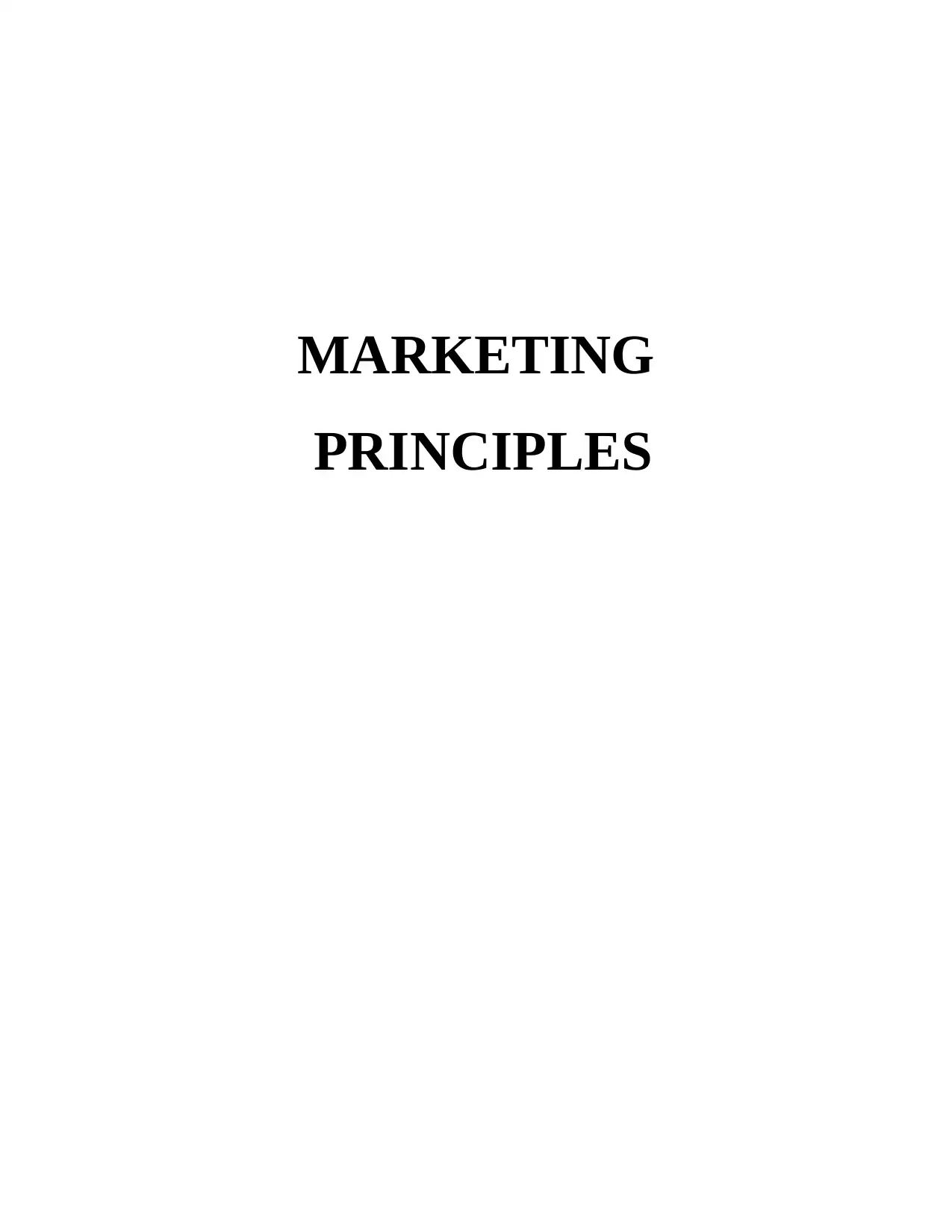
MARKETING
PRINCIPLES
PRINCIPLES
Paraphrase This Document
Need a fresh take? Get an instant paraphrase of this document with our AI Paraphraser
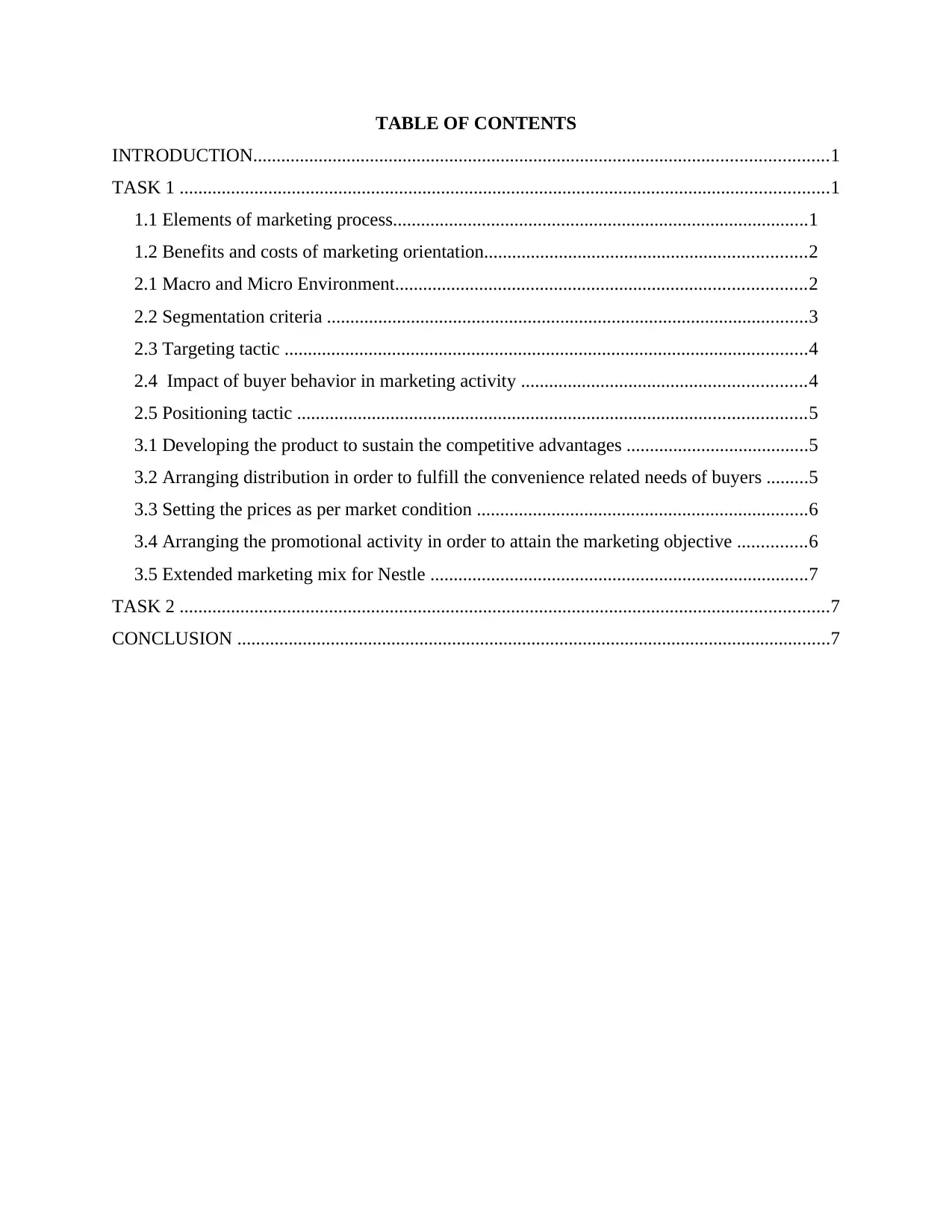
TABLE OF CONTENTS
INTRODUCTION...........................................................................................................................1
TASK 1 ...........................................................................................................................................1
1.1 Elements of marketing process.........................................................................................1
1.2 Benefits and costs of marketing orientation.....................................................................2
2.1 Macro and Micro Environment........................................................................................2
2.2 Segmentation criteria .......................................................................................................3
2.3 Targeting tactic ................................................................................................................4
2.4 Impact of buyer behavior in marketing activity .............................................................4
2.5 Positioning tactic .............................................................................................................5
3.1 Developing the product to sustain the competitive advantages .......................................5
3.2 Arranging distribution in order to fulfill the convenience related needs of buyers .........5
3.3 Setting the prices as per market condition .......................................................................6
3.4 Arranging the promotional activity in order to attain the marketing objective ...............6
3.5 Extended marketing mix for Nestle .................................................................................7
TASK 2 ...........................................................................................................................................7
CONCLUSION ...............................................................................................................................7
INTRODUCTION...........................................................................................................................1
TASK 1 ...........................................................................................................................................1
1.1 Elements of marketing process.........................................................................................1
1.2 Benefits and costs of marketing orientation.....................................................................2
2.1 Macro and Micro Environment........................................................................................2
2.2 Segmentation criteria .......................................................................................................3
2.3 Targeting tactic ................................................................................................................4
2.4 Impact of buyer behavior in marketing activity .............................................................4
2.5 Positioning tactic .............................................................................................................5
3.1 Developing the product to sustain the competitive advantages .......................................5
3.2 Arranging distribution in order to fulfill the convenience related needs of buyers .........5
3.3 Setting the prices as per market condition .......................................................................6
3.4 Arranging the promotional activity in order to attain the marketing objective ...............6
3.5 Extended marketing mix for Nestle .................................................................................7
TASK 2 ...........................................................................................................................................7
CONCLUSION ...............................................................................................................................7
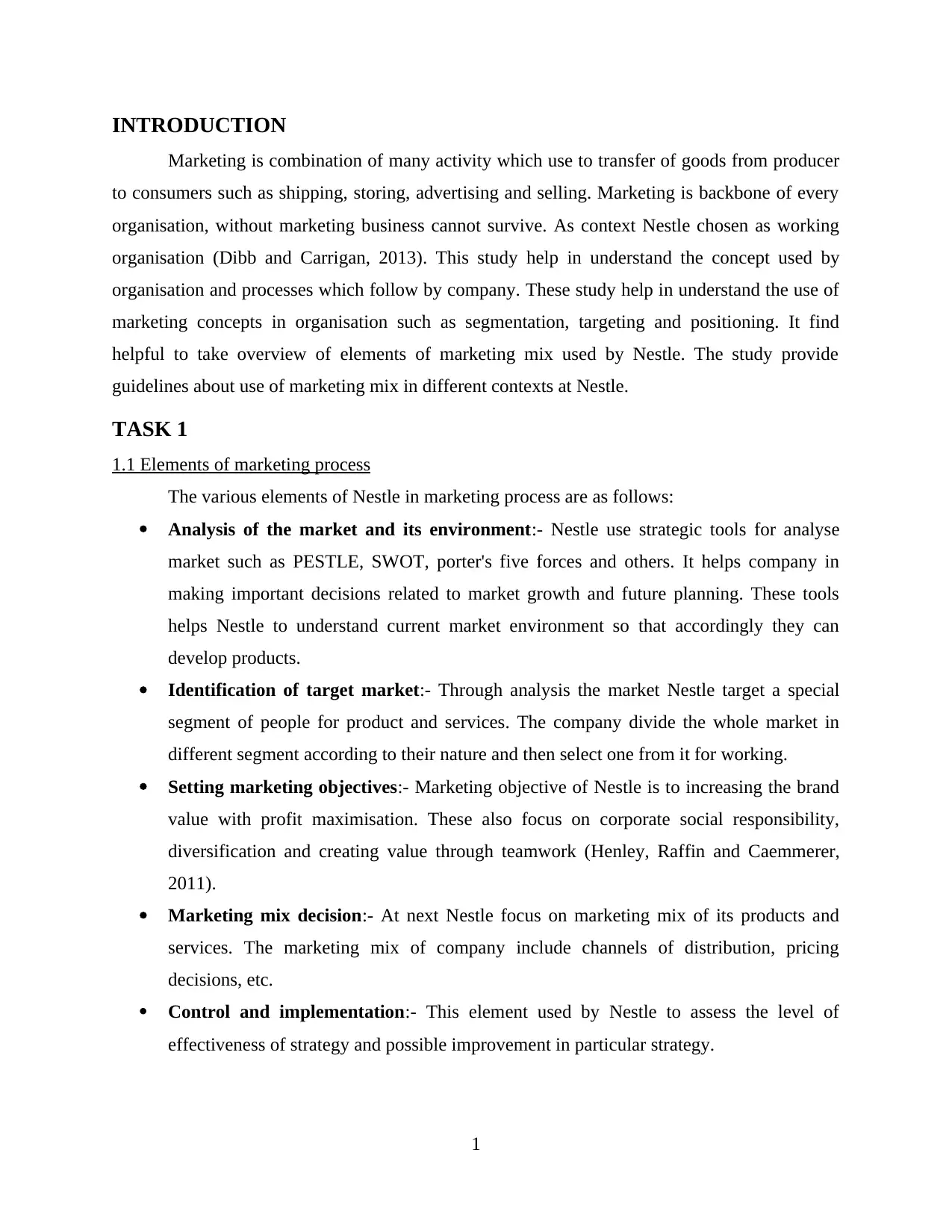
INTRODUCTION
Marketing is combination of many activity which use to transfer of goods from producer
to consumers such as shipping, storing, advertising and selling. Marketing is backbone of every
organisation, without marketing business cannot survive. As context Nestle chosen as working
organisation (Dibb and Carrigan, 2013). This study help in understand the concept used by
organisation and processes which follow by company. These study help in understand the use of
marketing concepts in organisation such as segmentation, targeting and positioning. It find
helpful to take overview of elements of marketing mix used by Nestle. The study provide
guidelines about use of marketing mix in different contexts at Nestle.
TASK 1
1.1 Elements of marketing process
The various elements of Nestle in marketing process are as follows:
Analysis of the market and its environment:- Nestle use strategic tools for analyse
market such as PESTLE, SWOT, porter's five forces and others. It helps company in
making important decisions related to market growth and future planning. These tools
helps Nestle to understand current market environment so that accordingly they can
develop products.
Identification of target market:- Through analysis the market Nestle target a special
segment of people for product and services. The company divide the whole market in
different segment according to their nature and then select one from it for working.
Setting marketing objectives:- Marketing objective of Nestle is to increasing the brand
value with profit maximisation. These also focus on corporate social responsibility,
diversification and creating value through teamwork (Henley, Raffin and Caemmerer,
2011).
Marketing mix decision:- At next Nestle focus on marketing mix of its products and
services. The marketing mix of company include channels of distribution, pricing
decisions, etc.
Control and implementation:- This element used by Nestle to assess the level of
effectiveness of strategy and possible improvement in particular strategy.
1
Marketing is combination of many activity which use to transfer of goods from producer
to consumers such as shipping, storing, advertising and selling. Marketing is backbone of every
organisation, without marketing business cannot survive. As context Nestle chosen as working
organisation (Dibb and Carrigan, 2013). This study help in understand the concept used by
organisation and processes which follow by company. These study help in understand the use of
marketing concepts in organisation such as segmentation, targeting and positioning. It find
helpful to take overview of elements of marketing mix used by Nestle. The study provide
guidelines about use of marketing mix in different contexts at Nestle.
TASK 1
1.1 Elements of marketing process
The various elements of Nestle in marketing process are as follows:
Analysis of the market and its environment:- Nestle use strategic tools for analyse
market such as PESTLE, SWOT, porter's five forces and others. It helps company in
making important decisions related to market growth and future planning. These tools
helps Nestle to understand current market environment so that accordingly they can
develop products.
Identification of target market:- Through analysis the market Nestle target a special
segment of people for product and services. The company divide the whole market in
different segment according to their nature and then select one from it for working.
Setting marketing objectives:- Marketing objective of Nestle is to increasing the brand
value with profit maximisation. These also focus on corporate social responsibility,
diversification and creating value through teamwork (Henley, Raffin and Caemmerer,
2011).
Marketing mix decision:- At next Nestle focus on marketing mix of its products and
services. The marketing mix of company include channels of distribution, pricing
decisions, etc.
Control and implementation:- This element used by Nestle to assess the level of
effectiveness of strategy and possible improvement in particular strategy.
1
⊘ This is a preview!⊘
Do you want full access?
Subscribe today to unlock all pages.

Trusted by 1+ million students worldwide
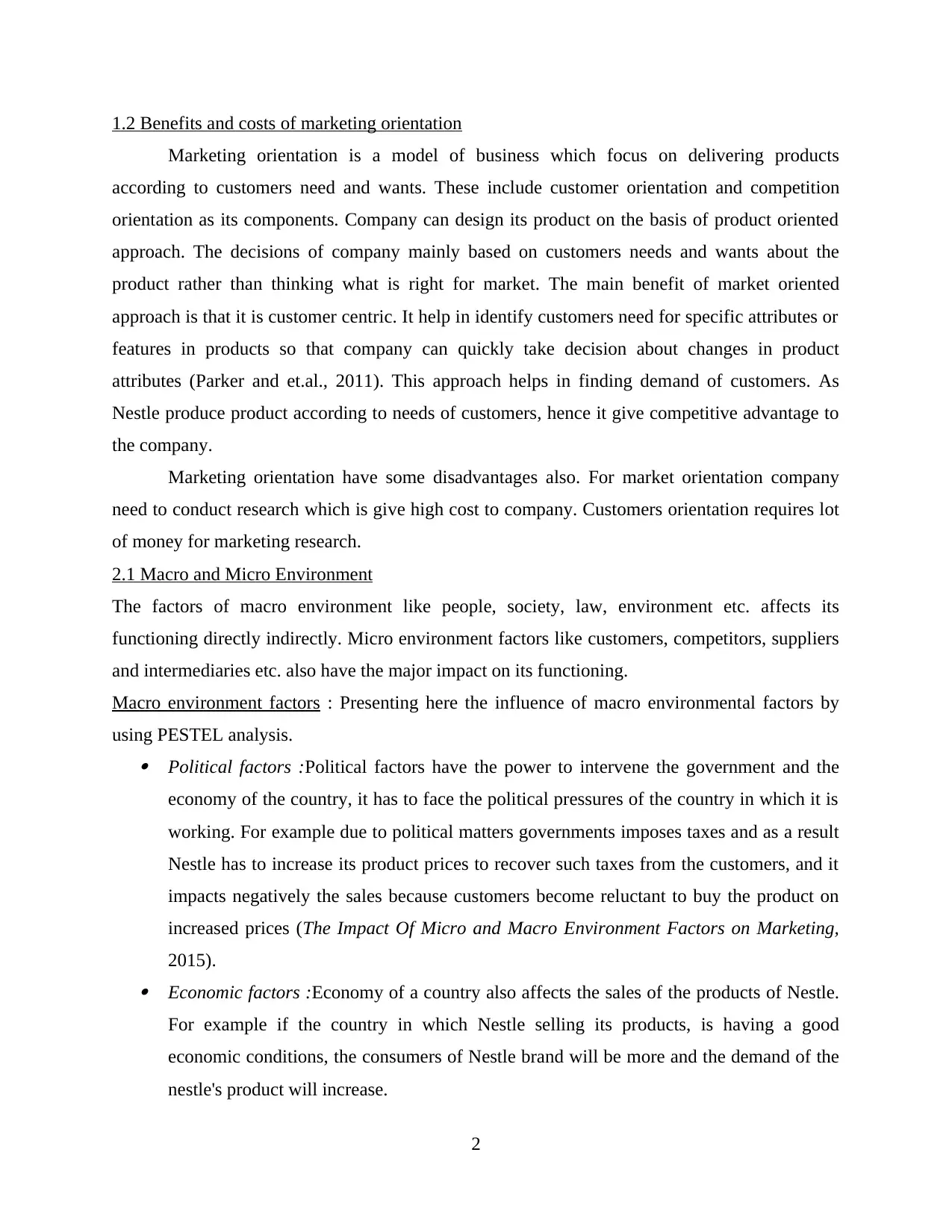
1.2 Benefits and costs of marketing orientation
Marketing orientation is a model of business which focus on delivering products
according to customers need and wants. These include customer orientation and competition
orientation as its components. Company can design its product on the basis of product oriented
approach. The decisions of company mainly based on customers needs and wants about the
product rather than thinking what is right for market. The main benefit of market oriented
approach is that it is customer centric. It help in identify customers need for specific attributes or
features in products so that company can quickly take decision about changes in product
attributes (Parker and et.al., 2011). This approach helps in finding demand of customers. As
Nestle produce product according to needs of customers, hence it give competitive advantage to
the company.
Marketing orientation have some disadvantages also. For market orientation company
need to conduct research which is give high cost to company. Customers orientation requires lot
of money for marketing research.
2.1 Macro and Micro Environment
The factors of macro environment like people, society, law, environment etc. affects its
functioning directly indirectly. Micro environment factors like customers, competitors, suppliers
and intermediaries etc. also have the major impact on its functioning.
Macro environment factors : Presenting here the influence of macro environmental factors by
using PESTEL analysis. Political factors :Political factors have the power to intervene the government and the
economy of the country, it has to face the political pressures of the country in which it is
working. For example due to political matters governments imposes taxes and as a result
Nestle has to increase its product prices to recover such taxes from the customers, and it
impacts negatively the sales because customers become reluctant to buy the product on
increased prices (The Impact Of Micro and Macro Environment Factors on Marketing,
2015). Economic factors :Economy of a country also affects the sales of the products of Nestle.
For example if the country in which Nestle selling its products, is having a good
economic conditions, the consumers of Nestle brand will be more and the demand of the
nestle's product will increase.
2
Marketing orientation is a model of business which focus on delivering products
according to customers need and wants. These include customer orientation and competition
orientation as its components. Company can design its product on the basis of product oriented
approach. The decisions of company mainly based on customers needs and wants about the
product rather than thinking what is right for market. The main benefit of market oriented
approach is that it is customer centric. It help in identify customers need for specific attributes or
features in products so that company can quickly take decision about changes in product
attributes (Parker and et.al., 2011). This approach helps in finding demand of customers. As
Nestle produce product according to needs of customers, hence it give competitive advantage to
the company.
Marketing orientation have some disadvantages also. For market orientation company
need to conduct research which is give high cost to company. Customers orientation requires lot
of money for marketing research.
2.1 Macro and Micro Environment
The factors of macro environment like people, society, law, environment etc. affects its
functioning directly indirectly. Micro environment factors like customers, competitors, suppliers
and intermediaries etc. also have the major impact on its functioning.
Macro environment factors : Presenting here the influence of macro environmental factors by
using PESTEL analysis. Political factors :Political factors have the power to intervene the government and the
economy of the country, it has to face the political pressures of the country in which it is
working. For example due to political matters governments imposes taxes and as a result
Nestle has to increase its product prices to recover such taxes from the customers, and it
impacts negatively the sales because customers become reluctant to buy the product on
increased prices (The Impact Of Micro and Macro Environment Factors on Marketing,
2015). Economic factors :Economy of a country also affects the sales of the products of Nestle.
For example if the country in which Nestle selling its products, is having a good
economic conditions, the consumers of Nestle brand will be more and the demand of the
nestle's product will increase.
2
Paraphrase This Document
Need a fresh take? Get an instant paraphrase of this document with our AI Paraphraser
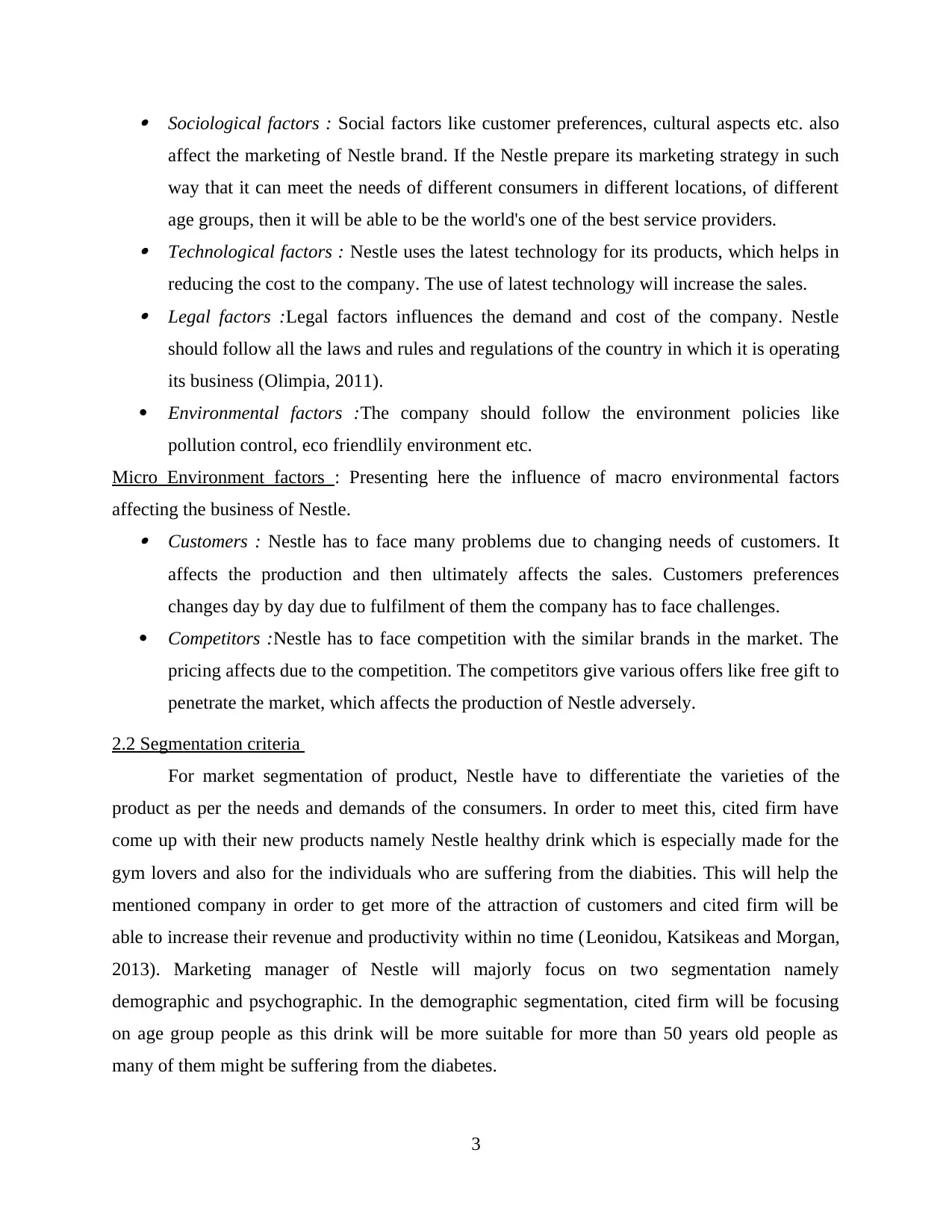
Sociological factors : Social factors like customer preferences, cultural aspects etc. also
affect the marketing of Nestle brand. If the Nestle prepare its marketing strategy in such
way that it can meet the needs of different consumers in different locations, of different
age groups, then it will be able to be the world's one of the best service providers. Technological factors : Nestle uses the latest technology for its products, which helps in
reducing the cost to the company. The use of latest technology will increase the sales. Legal factors :Legal factors influences the demand and cost of the company. Nestle
should follow all the laws and rules and regulations of the country in which it is operating
its business (Olimpia, 2011).
Environmental factors :The company should follow the environment policies like
pollution control, eco friendlily environment etc.
Micro Environment factors : Presenting here the influence of macro environmental factors
affecting the business of Nestle. Customers : Nestle has to face many problems due to changing needs of customers. It
affects the production and then ultimately affects the sales. Customers preferences
changes day by day due to fulfilment of them the company has to face challenges.
Competitors :Nestle has to face competition with the similar brands in the market. The
pricing affects due to the competition. The competitors give various offers like free gift to
penetrate the market, which affects the production of Nestle adversely.
2.2 Segmentation criteria
For market segmentation of product, Nestle have to differentiate the varieties of the
product as per the needs and demands of the consumers. In order to meet this, cited firm have
come up with their new products namely Nestle healthy drink which is especially made for the
gym lovers and also for the individuals who are suffering from the diabities. This will help the
mentioned company in order to get more of the attraction of customers and cited firm will be
able to increase their revenue and productivity within no time (Leonidou, Katsikeas and Morgan,
2013). Marketing manager of Nestle will majorly focus on two segmentation namely
demographic and psychographic. In the demographic segmentation, cited firm will be focusing
on age group people as this drink will be more suitable for more than 50 years old people as
many of them might be suffering from the diabetes.
3
affect the marketing of Nestle brand. If the Nestle prepare its marketing strategy in such
way that it can meet the needs of different consumers in different locations, of different
age groups, then it will be able to be the world's one of the best service providers. Technological factors : Nestle uses the latest technology for its products, which helps in
reducing the cost to the company. The use of latest technology will increase the sales. Legal factors :Legal factors influences the demand and cost of the company. Nestle
should follow all the laws and rules and regulations of the country in which it is operating
its business (Olimpia, 2011).
Environmental factors :The company should follow the environment policies like
pollution control, eco friendlily environment etc.
Micro Environment factors : Presenting here the influence of macro environmental factors
affecting the business of Nestle. Customers : Nestle has to face many problems due to changing needs of customers. It
affects the production and then ultimately affects the sales. Customers preferences
changes day by day due to fulfilment of them the company has to face challenges.
Competitors :Nestle has to face competition with the similar brands in the market. The
pricing affects due to the competition. The competitors give various offers like free gift to
penetrate the market, which affects the production of Nestle adversely.
2.2 Segmentation criteria
For market segmentation of product, Nestle have to differentiate the varieties of the
product as per the needs and demands of the consumers. In order to meet this, cited firm have
come up with their new products namely Nestle healthy drink which is especially made for the
gym lovers and also for the individuals who are suffering from the diabities. This will help the
mentioned company in order to get more of the attraction of customers and cited firm will be
able to increase their revenue and productivity within no time (Leonidou, Katsikeas and Morgan,
2013). Marketing manager of Nestle will majorly focus on two segmentation namely
demographic and psychographic. In the demographic segmentation, cited firm will be focusing
on age group people as this drink will be more suitable for more than 50 years old people as
many of them might be suffering from the diabetes.
3
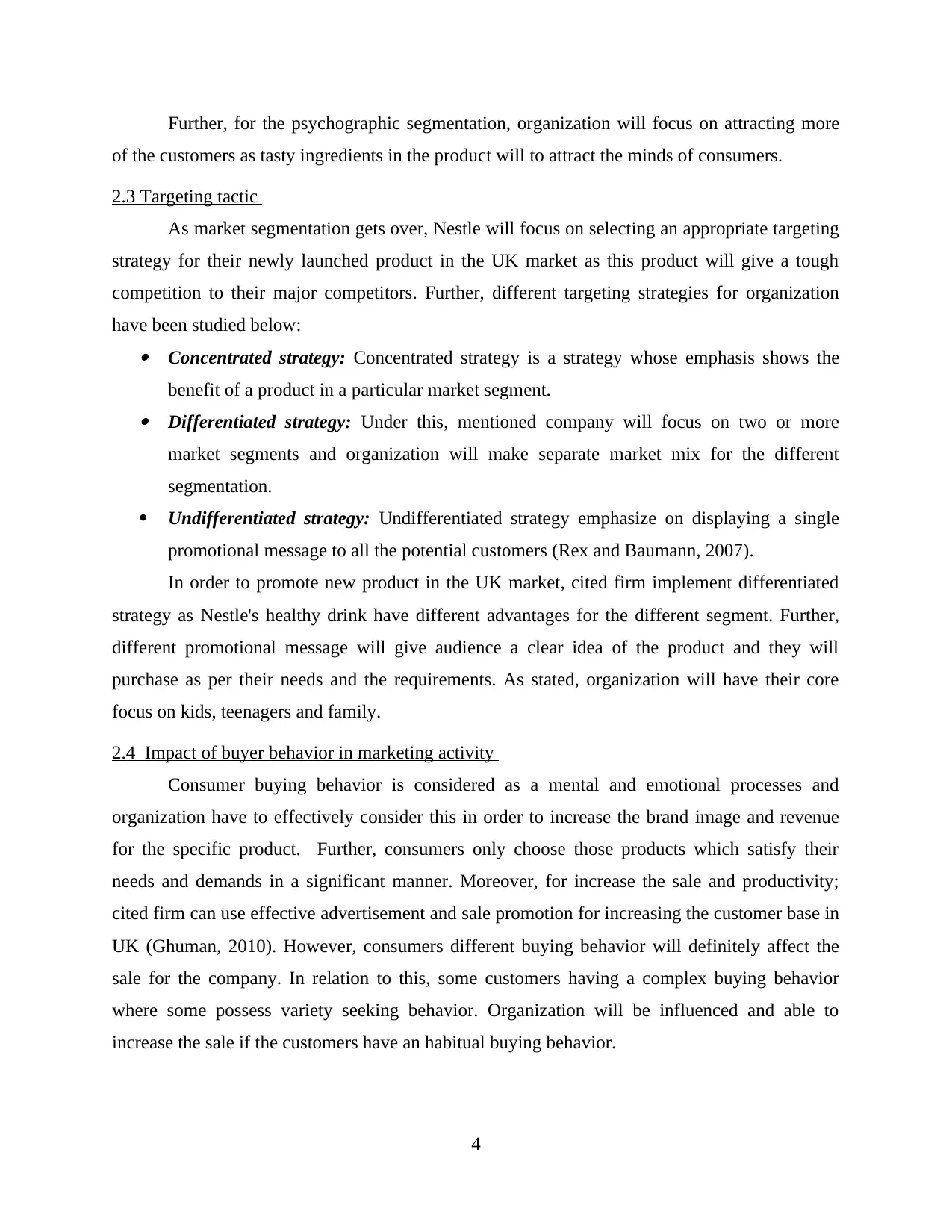
Further, for the psychographic segmentation, organization will focus on attracting more
of the customers as tasty ingredients in the product will to attract the minds of consumers.
2.3 Targeting tactic
As market segmentation gets over, Nestle will focus on selecting an appropriate targeting
strategy for their newly launched product in the UK market as this product will give a tough
competition to their major competitors. Further, different targeting strategies for organization
have been studied below: Concentrated strategy: Concentrated strategy is a strategy whose emphasis shows the
benefit of a product in a particular market segment. Differentiated strategy: Under this, mentioned company will focus on two or more
market segments and organization will make separate market mix for the different
segmentation.
Undifferentiated strategy: Undifferentiated strategy emphasize on displaying a single
promotional message to all the potential customers (Rex and Baumann, 2007).
In order to promote new product in the UK market, cited firm implement differentiated
strategy as Nestle's healthy drink have different advantages for the different segment. Further,
different promotional message will give audience a clear idea of the product and they will
purchase as per their needs and the requirements. As stated, organization will have their core
focus on kids, teenagers and family.
2.4 Impact of buyer behavior in marketing activity
Consumer buying behavior is considered as a mental and emotional processes and
organization have to effectively consider this in order to increase the brand image and revenue
for the specific product. Further, consumers only choose those products which satisfy their
needs and demands in a significant manner. Moreover, for increase the sale and productivity;
cited firm can use effective advertisement and sale promotion for increasing the customer base in
UK (Ghuman, 2010). However, consumers different buying behavior will definitely affect the
sale for the company. In relation to this, some customers having a complex buying behavior
where some possess variety seeking behavior. Organization will be influenced and able to
increase the sale if the customers have an habitual buying behavior.
4
of the customers as tasty ingredients in the product will to attract the minds of consumers.
2.3 Targeting tactic
As market segmentation gets over, Nestle will focus on selecting an appropriate targeting
strategy for their newly launched product in the UK market as this product will give a tough
competition to their major competitors. Further, different targeting strategies for organization
have been studied below: Concentrated strategy: Concentrated strategy is a strategy whose emphasis shows the
benefit of a product in a particular market segment. Differentiated strategy: Under this, mentioned company will focus on two or more
market segments and organization will make separate market mix for the different
segmentation.
Undifferentiated strategy: Undifferentiated strategy emphasize on displaying a single
promotional message to all the potential customers (Rex and Baumann, 2007).
In order to promote new product in the UK market, cited firm implement differentiated
strategy as Nestle's healthy drink have different advantages for the different segment. Further,
different promotional message will give audience a clear idea of the product and they will
purchase as per their needs and the requirements. As stated, organization will have their core
focus on kids, teenagers and family.
2.4 Impact of buyer behavior in marketing activity
Consumer buying behavior is considered as a mental and emotional processes and
organization have to effectively consider this in order to increase the brand image and revenue
for the specific product. Further, consumers only choose those products which satisfy their
needs and demands in a significant manner. Moreover, for increase the sale and productivity;
cited firm can use effective advertisement and sale promotion for increasing the customer base in
UK (Ghuman, 2010). However, consumers different buying behavior will definitely affect the
sale for the company. In relation to this, some customers having a complex buying behavior
where some possess variety seeking behavior. Organization will be influenced and able to
increase the sale if the customers have an habitual buying behavior.
4
⊘ This is a preview!⊘
Do you want full access?
Subscribe today to unlock all pages.

Trusted by 1+ million students worldwide
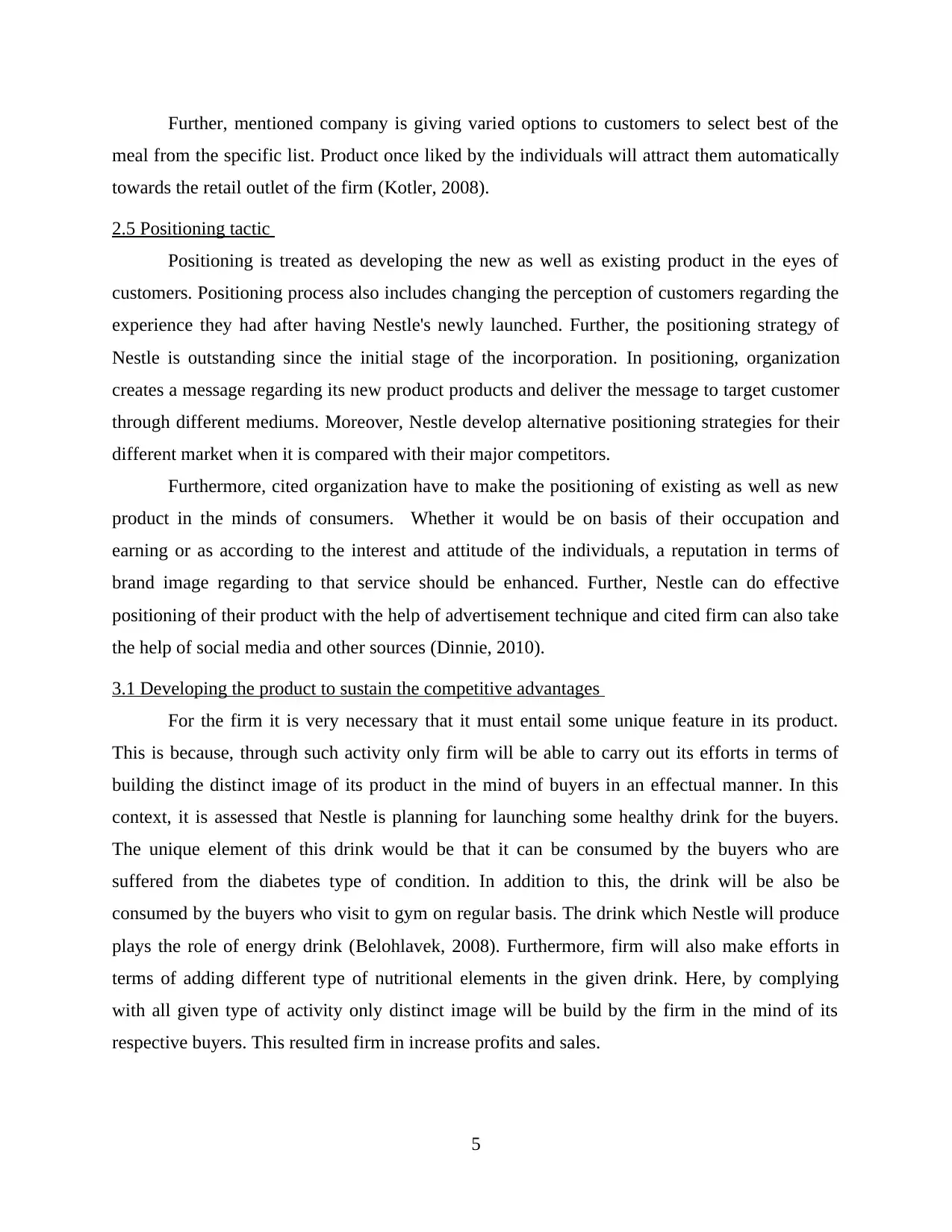
Further, mentioned company is giving varied options to customers to select best of the
meal from the specific list. Product once liked by the individuals will attract them automatically
towards the retail outlet of the firm (Kotler, 2008).
2.5 Positioning tactic
Positioning is treated as developing the new as well as existing product in the eyes of
customers. Positioning process also includes changing the perception of customers regarding the
experience they had after having Nestle's newly launched. Further, the positioning strategy of
Nestle is outstanding since the initial stage of the incorporation. In positioning, organization
creates a message regarding its new product products and deliver the message to target customer
through different mediums. Moreover, Nestle develop alternative positioning strategies for their
different market when it is compared with their major competitors.
Furthermore, cited organization have to make the positioning of existing as well as new
product in the minds of consumers. Whether it would be on basis of their occupation and
earning or as according to the interest and attitude of the individuals, a reputation in terms of
brand image regarding to that service should be enhanced. Further, Nestle can do effective
positioning of their product with the help of advertisement technique and cited firm can also take
the help of social media and other sources (Dinnie, 2010).
3.1 Developing the product to sustain the competitive advantages
For the firm it is very necessary that it must entail some unique feature in its product.
This is because, through such activity only firm will be able to carry out its efforts in terms of
building the distinct image of its product in the mind of buyers in an effectual manner. In this
context, it is assessed that Nestle is planning for launching some healthy drink for the buyers.
The unique element of this drink would be that it can be consumed by the buyers who are
suffered from the diabetes type of condition. In addition to this, the drink will be also be
consumed by the buyers who visit to gym on regular basis. The drink which Nestle will produce
plays the role of energy drink (Belohlavek, 2008). Furthermore, firm will also make efforts in
terms of adding different type of nutritional elements in the given drink. Here, by complying
with all given type of activity only distinct image will be build by the firm in the mind of its
respective buyers. This resulted firm in increase profits and sales.
5
meal from the specific list. Product once liked by the individuals will attract them automatically
towards the retail outlet of the firm (Kotler, 2008).
2.5 Positioning tactic
Positioning is treated as developing the new as well as existing product in the eyes of
customers. Positioning process also includes changing the perception of customers regarding the
experience they had after having Nestle's newly launched. Further, the positioning strategy of
Nestle is outstanding since the initial stage of the incorporation. In positioning, organization
creates a message regarding its new product products and deliver the message to target customer
through different mediums. Moreover, Nestle develop alternative positioning strategies for their
different market when it is compared with their major competitors.
Furthermore, cited organization have to make the positioning of existing as well as new
product in the minds of consumers. Whether it would be on basis of their occupation and
earning or as according to the interest and attitude of the individuals, a reputation in terms of
brand image regarding to that service should be enhanced. Further, Nestle can do effective
positioning of their product with the help of advertisement technique and cited firm can also take
the help of social media and other sources (Dinnie, 2010).
3.1 Developing the product to sustain the competitive advantages
For the firm it is very necessary that it must entail some unique feature in its product.
This is because, through such activity only firm will be able to carry out its efforts in terms of
building the distinct image of its product in the mind of buyers in an effectual manner. In this
context, it is assessed that Nestle is planning for launching some healthy drink for the buyers.
The unique element of this drink would be that it can be consumed by the buyers who are
suffered from the diabetes type of condition. In addition to this, the drink will be also be
consumed by the buyers who visit to gym on regular basis. The drink which Nestle will produce
plays the role of energy drink (Belohlavek, 2008). Furthermore, firm will also make efforts in
terms of adding different type of nutritional elements in the given drink. Here, by complying
with all given type of activity only distinct image will be build by the firm in the mind of its
respective buyers. This resulted firm in increase profits and sales.
5
Paraphrase This Document
Need a fresh take? Get an instant paraphrase of this document with our AI Paraphraser
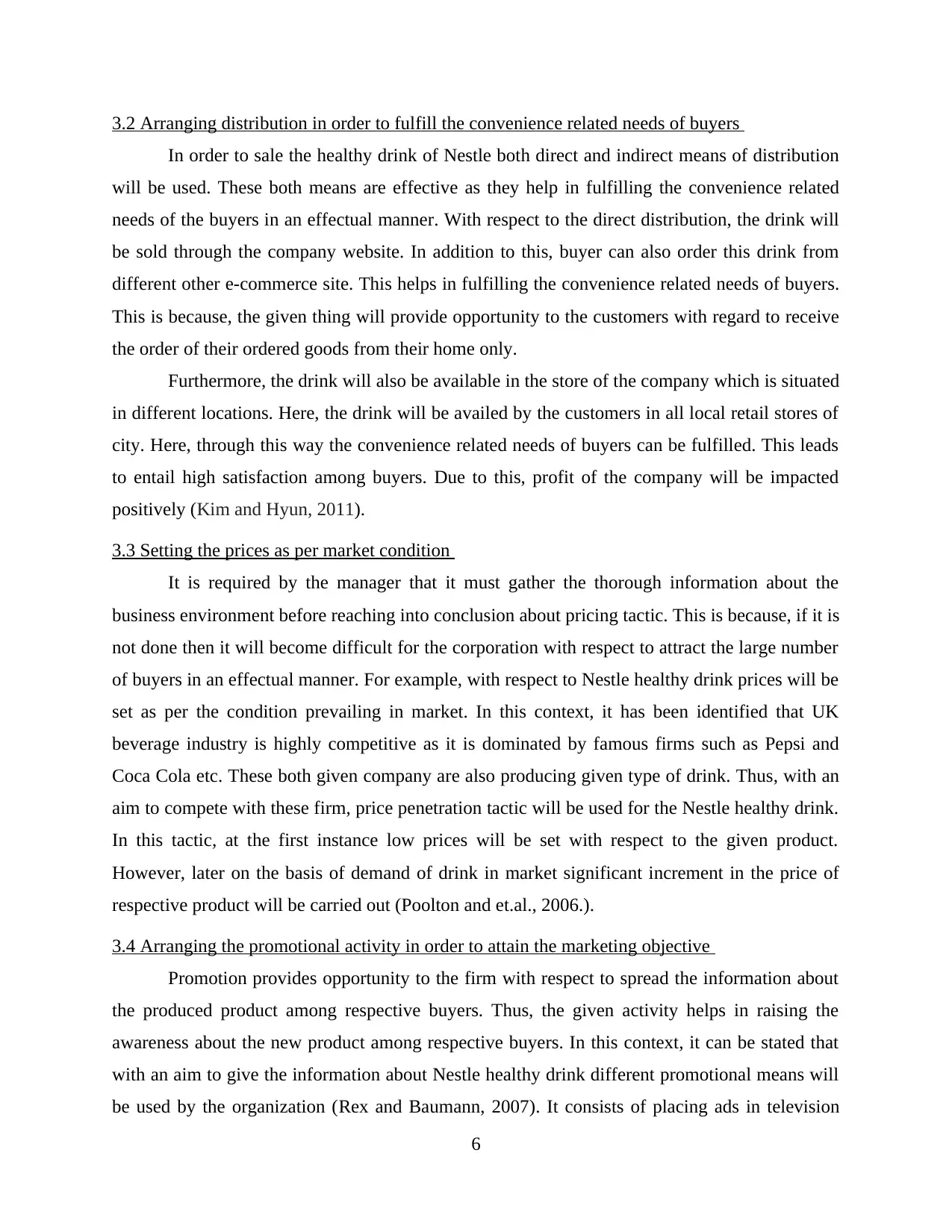
3.2 Arranging distribution in order to fulfill the convenience related needs of buyers
In order to sale the healthy drink of Nestle both direct and indirect means of distribution
will be used. These both means are effective as they help in fulfilling the convenience related
needs of the buyers in an effectual manner. With respect to the direct distribution, the drink will
be sold through the company website. In addition to this, buyer can also order this drink from
different other e-commerce site. This helps in fulfilling the convenience related needs of buyers.
This is because, the given thing will provide opportunity to the customers with regard to receive
the order of their ordered goods from their home only.
Furthermore, the drink will also be available in the store of the company which is situated
in different locations. Here, the drink will be availed by the customers in all local retail stores of
city. Here, through this way the convenience related needs of buyers can be fulfilled. This leads
to entail high satisfaction among buyers. Due to this, profit of the company will be impacted
positively (Kim and Hyun, 2011).
3.3 Setting the prices as per market condition
It is required by the manager that it must gather the thorough information about the
business environment before reaching into conclusion about pricing tactic. This is because, if it is
not done then it will become difficult for the corporation with respect to attract the large number
of buyers in an effectual manner. For example, with respect to Nestle healthy drink prices will be
set as per the condition prevailing in market. In this context, it has been identified that UK
beverage industry is highly competitive as it is dominated by famous firms such as Pepsi and
Coca Cola etc. These both given company are also producing given type of drink. Thus, with an
aim to compete with these firm, price penetration tactic will be used for the Nestle healthy drink.
In this tactic, at the first instance low prices will be set with respect to the given product.
However, later on the basis of demand of drink in market significant increment in the price of
respective product will be carried out (Poolton and et.al., 2006.).
3.4 Arranging the promotional activity in order to attain the marketing objective
Promotion provides opportunity to the firm with respect to spread the information about
the produced product among respective buyers. Thus, the given activity helps in raising the
awareness about the new product among respective buyers. In this context, it can be stated that
with an aim to give the information about Nestle healthy drink different promotional means will
be used by the organization (Rex and Baumann, 2007). It consists of placing ads in television
6
In order to sale the healthy drink of Nestle both direct and indirect means of distribution
will be used. These both means are effective as they help in fulfilling the convenience related
needs of the buyers in an effectual manner. With respect to the direct distribution, the drink will
be sold through the company website. In addition to this, buyer can also order this drink from
different other e-commerce site. This helps in fulfilling the convenience related needs of buyers.
This is because, the given thing will provide opportunity to the customers with regard to receive
the order of their ordered goods from their home only.
Furthermore, the drink will also be available in the store of the company which is situated
in different locations. Here, the drink will be availed by the customers in all local retail stores of
city. Here, through this way the convenience related needs of buyers can be fulfilled. This leads
to entail high satisfaction among buyers. Due to this, profit of the company will be impacted
positively (Kim and Hyun, 2011).
3.3 Setting the prices as per market condition
It is required by the manager that it must gather the thorough information about the
business environment before reaching into conclusion about pricing tactic. This is because, if it is
not done then it will become difficult for the corporation with respect to attract the large number
of buyers in an effectual manner. For example, with respect to Nestle healthy drink prices will be
set as per the condition prevailing in market. In this context, it has been identified that UK
beverage industry is highly competitive as it is dominated by famous firms such as Pepsi and
Coca Cola etc. These both given company are also producing given type of drink. Thus, with an
aim to compete with these firm, price penetration tactic will be used for the Nestle healthy drink.
In this tactic, at the first instance low prices will be set with respect to the given product.
However, later on the basis of demand of drink in market significant increment in the price of
respective product will be carried out (Poolton and et.al., 2006.).
3.4 Arranging the promotional activity in order to attain the marketing objective
Promotion provides opportunity to the firm with respect to spread the information about
the produced product among respective buyers. Thus, the given activity helps in raising the
awareness about the new product among respective buyers. In this context, it can be stated that
with an aim to give the information about Nestle healthy drink different promotional means will
be used by the organization (Rex and Baumann, 2007). It consists of placing ads in television
6
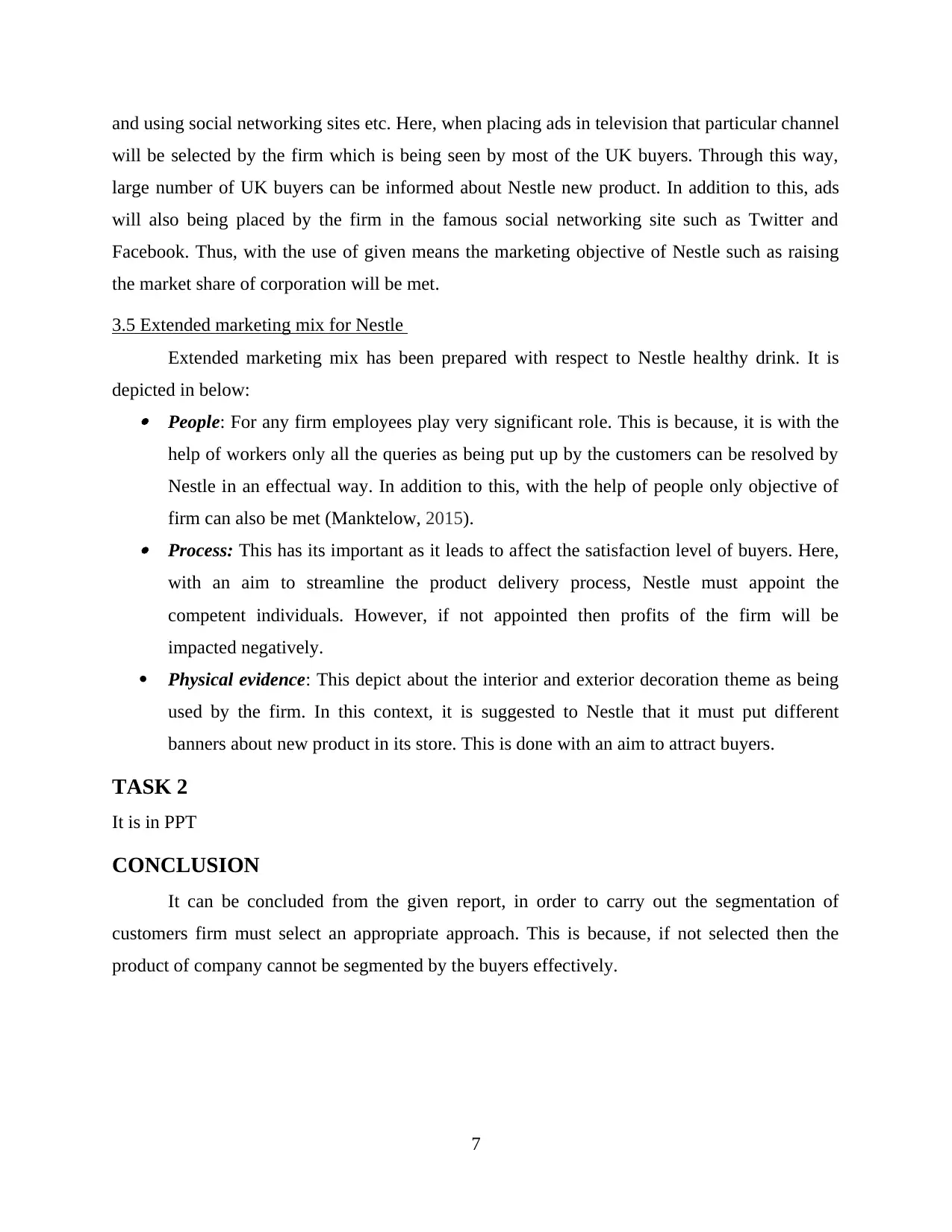
and using social networking sites etc. Here, when placing ads in television that particular channel
will be selected by the firm which is being seen by most of the UK buyers. Through this way,
large number of UK buyers can be informed about Nestle new product. In addition to this, ads
will also being placed by the firm in the famous social networking site such as Twitter and
Facebook. Thus, with the use of given means the marketing objective of Nestle such as raising
the market share of corporation will be met.
3.5 Extended marketing mix for Nestle
Extended marketing mix has been prepared with respect to Nestle healthy drink. It is
depicted in below: People: For any firm employees play very significant role. This is because, it is with the
help of workers only all the queries as being put up by the customers can be resolved by
Nestle in an effectual way. In addition to this, with the help of people only objective of
firm can also be met (Manktelow, 2015). Process: This has its important as it leads to affect the satisfaction level of buyers. Here,
with an aim to streamline the product delivery process, Nestle must appoint the
competent individuals. However, if not appointed then profits of the firm will be
impacted negatively.
Physical evidence: This depict about the interior and exterior decoration theme as being
used by the firm. In this context, it is suggested to Nestle that it must put different
banners about new product in its store. This is done with an aim to attract buyers.
TASK 2
It is in PPT
CONCLUSION
It can be concluded from the given report, in order to carry out the segmentation of
customers firm must select an appropriate approach. This is because, if not selected then the
product of company cannot be segmented by the buyers effectively.
7
will be selected by the firm which is being seen by most of the UK buyers. Through this way,
large number of UK buyers can be informed about Nestle new product. In addition to this, ads
will also being placed by the firm in the famous social networking site such as Twitter and
Facebook. Thus, with the use of given means the marketing objective of Nestle such as raising
the market share of corporation will be met.
3.5 Extended marketing mix for Nestle
Extended marketing mix has been prepared with respect to Nestle healthy drink. It is
depicted in below: People: For any firm employees play very significant role. This is because, it is with the
help of workers only all the queries as being put up by the customers can be resolved by
Nestle in an effectual way. In addition to this, with the help of people only objective of
firm can also be met (Manktelow, 2015). Process: This has its important as it leads to affect the satisfaction level of buyers. Here,
with an aim to streamline the product delivery process, Nestle must appoint the
competent individuals. However, if not appointed then profits of the firm will be
impacted negatively.
Physical evidence: This depict about the interior and exterior decoration theme as being
used by the firm. In this context, it is suggested to Nestle that it must put different
banners about new product in its store. This is done with an aim to attract buyers.
TASK 2
It is in PPT
CONCLUSION
It can be concluded from the given report, in order to carry out the segmentation of
customers firm must select an appropriate approach. This is because, if not selected then the
product of company cannot be segmented by the buyers effectively.
7
⊘ This is a preview!⊘
Do you want full access?
Subscribe today to unlock all pages.

Trusted by 1+ million students worldwide
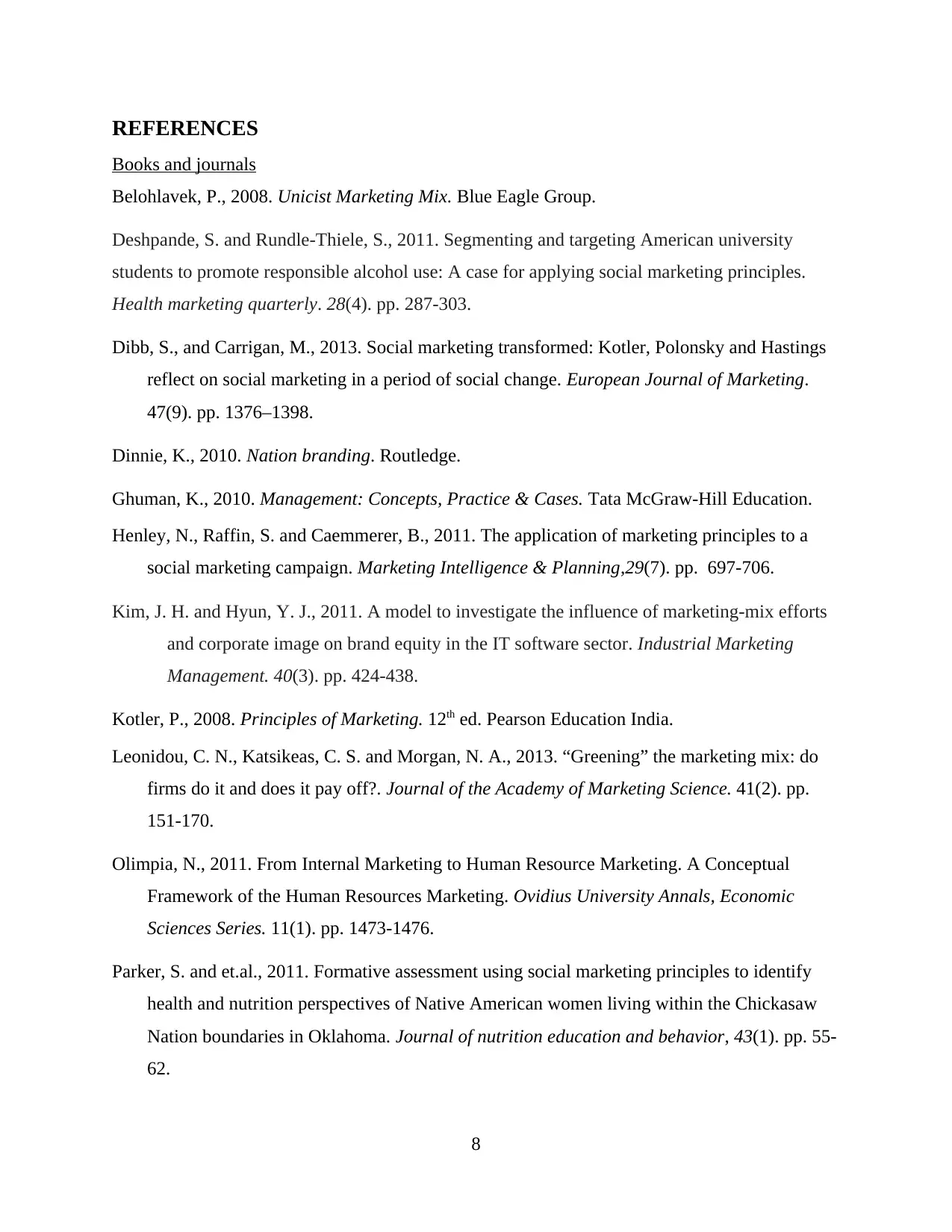
REFERENCES
Books and journals
Belohlavek, P., 2008. Unicist Marketing Mix. Blue Eagle Group.
Deshpande, S. and Rundle-Thiele, S., 2011. Segmenting and targeting American university
students to promote responsible alcohol use: A case for applying social marketing principles.
Health marketing quarterly. 28(4). pp. 287-303.
Dibb, S., and Carrigan, M., 2013. Social marketing transformed: Kotler, Polonsky and Hastings
reflect on social marketing in a period of social change. European Journal of Marketing.
47(9). pp. 1376–1398.
Dinnie, K., 2010. Nation branding. Routledge.
Ghuman, K., 2010. Management: Concepts, Practice & Cases. Tata McGraw-Hill Education.
Henley, N., Raffin, S. and Caemmerer, B., 2011. The application of marketing principles to a
social marketing campaign. Marketing Intelligence & Planning,29(7). pp. 697-706.
Kim, J. H. and Hyun, Y. J., 2011. A model to investigate the influence of marketing-mix efforts
and corporate image on brand equity in the IT software sector. Industrial Marketing
Management. 40(3). pp. 424-438.
Kotler, P., 2008. Principles of Marketing. 12th ed. Pearson Education India.
Leonidou, C. N., Katsikeas, C. S. and Morgan, N. A., 2013. “Greening” the marketing mix: do
firms do it and does it pay off?. Journal of the Academy of Marketing Science. 41(2). pp.
151-170.
Olimpia, N., 2011. From Internal Marketing to Human Resource Marketing. A Conceptual
Framework of the Human Resources Marketing. Ovidius University Annals, Economic
Sciences Series. 11(1). pp. 1473-1476.
Parker, S. and et.al., 2011. Formative assessment using social marketing principles to identify
health and nutrition perspectives of Native American women living within the Chickasaw
Nation boundaries in Oklahoma. Journal of nutrition education and behavior, 43(1). pp. 55-
62.
8
Books and journals
Belohlavek, P., 2008. Unicist Marketing Mix. Blue Eagle Group.
Deshpande, S. and Rundle-Thiele, S., 2011. Segmenting and targeting American university
students to promote responsible alcohol use: A case for applying social marketing principles.
Health marketing quarterly. 28(4). pp. 287-303.
Dibb, S., and Carrigan, M., 2013. Social marketing transformed: Kotler, Polonsky and Hastings
reflect on social marketing in a period of social change. European Journal of Marketing.
47(9). pp. 1376–1398.
Dinnie, K., 2010. Nation branding. Routledge.
Ghuman, K., 2010. Management: Concepts, Practice & Cases. Tata McGraw-Hill Education.
Henley, N., Raffin, S. and Caemmerer, B., 2011. The application of marketing principles to a
social marketing campaign. Marketing Intelligence & Planning,29(7). pp. 697-706.
Kim, J. H. and Hyun, Y. J., 2011. A model to investigate the influence of marketing-mix efforts
and corporate image on brand equity in the IT software sector. Industrial Marketing
Management. 40(3). pp. 424-438.
Kotler, P., 2008. Principles of Marketing. 12th ed. Pearson Education India.
Leonidou, C. N., Katsikeas, C. S. and Morgan, N. A., 2013. “Greening” the marketing mix: do
firms do it and does it pay off?. Journal of the Academy of Marketing Science. 41(2). pp.
151-170.
Olimpia, N., 2011. From Internal Marketing to Human Resource Marketing. A Conceptual
Framework of the Human Resources Marketing. Ovidius University Annals, Economic
Sciences Series. 11(1). pp. 1473-1476.
Parker, S. and et.al., 2011. Formative assessment using social marketing principles to identify
health and nutrition perspectives of Native American women living within the Chickasaw
Nation boundaries in Oklahoma. Journal of nutrition education and behavior, 43(1). pp. 55-
62.
8
Paraphrase This Document
Need a fresh take? Get an instant paraphrase of this document with our AI Paraphraser
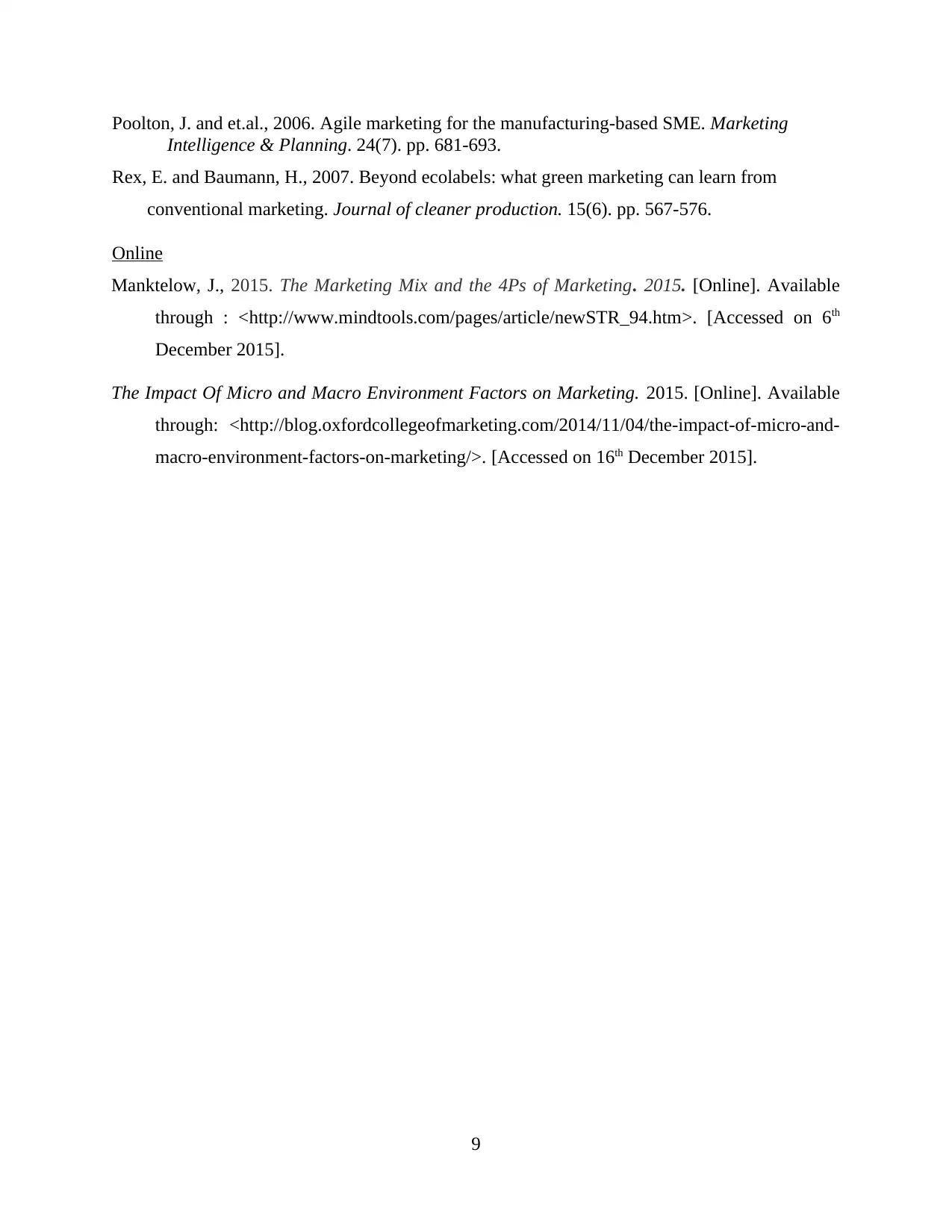
Poolton, J. and et.al., 2006. Agile marketing for the manufacturing-based SME. Marketing
Intelligence & Planning. 24(7). pp. 681-693.
Rex, E. and Baumann, H., 2007. Beyond ecolabels: what green marketing can learn from
conventional marketing. Journal of cleaner production. 15(6). pp. 567-576.
Online
Manktelow, J., 2015. The Marketing Mix and the 4Ps of Marketing. 2015. [Online]. Available
through : <http://www.mindtools.com/pages/article/newSTR_94.htm>. [Accessed on 6th
December 2015].
The Impact Of Micro and Macro Environment Factors on Marketing. 2015. [Online]. Available
through: <http://blog.oxfordcollegeofmarketing.com/2014/11/04/the-impact-of-micro-and-
macro-environment-factors-on-marketing/>. [Accessed on 16th December 2015].
9
Intelligence & Planning. 24(7). pp. 681-693.
Rex, E. and Baumann, H., 2007. Beyond ecolabels: what green marketing can learn from
conventional marketing. Journal of cleaner production. 15(6). pp. 567-576.
Online
Manktelow, J., 2015. The Marketing Mix and the 4Ps of Marketing. 2015. [Online]. Available
through : <http://www.mindtools.com/pages/article/newSTR_94.htm>. [Accessed on 6th
December 2015].
The Impact Of Micro and Macro Environment Factors on Marketing. 2015. [Online]. Available
through: <http://blog.oxfordcollegeofmarketing.com/2014/11/04/the-impact-of-micro-and-
macro-environment-factors-on-marketing/>. [Accessed on 16th December 2015].
9
1 out of 11
Related Documents
Your All-in-One AI-Powered Toolkit for Academic Success.
+13062052269
info@desklib.com
Available 24*7 on WhatsApp / Email
![[object Object]](/_next/static/media/star-bottom.7253800d.svg)
Unlock your academic potential
Copyright © 2020–2025 A2Z Services. All Rights Reserved. Developed and managed by ZUCOL.





